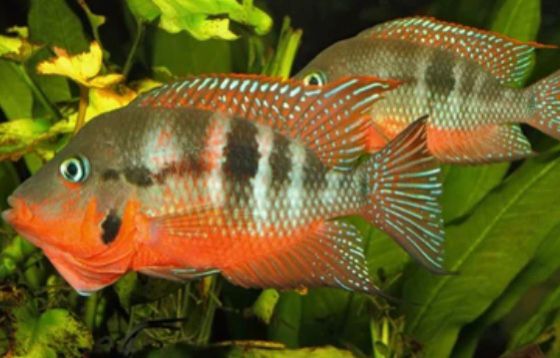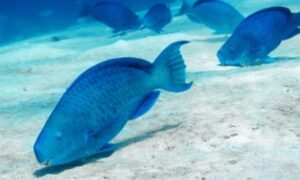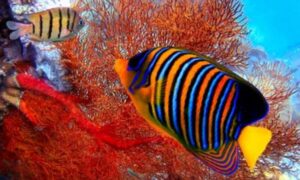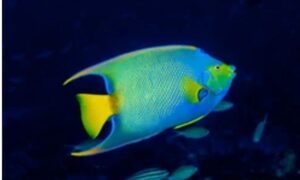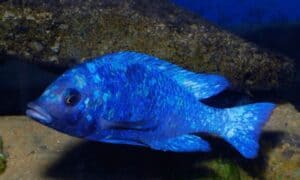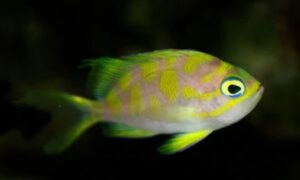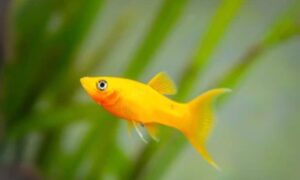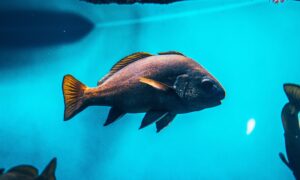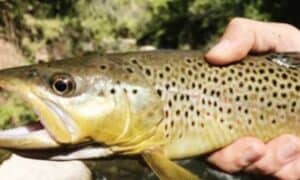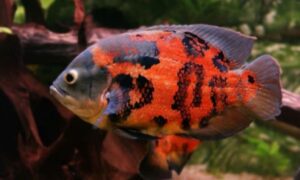Table of Contents
Introduction to Firemouth Cichlid
The firemouth cichlid is a fascinating freshwater specie. They are from the family of Cichlidae. They are a popular choice for aquariums because of their beautiful appearance. Their scientific name is Thorichthys meeki. They are basically native to Central America but they are also found in the Yucatán Peninsula in Mexico. You might be thinking why they are called firemouth cichlids!! So this is because they have a very bright orange coloration on the under area of their jaws. Firemouth cichlids are found in slow-moving waters when they are in the wild. They have a lifespan of 15 years.
Fish keepers like to keep firemouth cichlids as their pets because it’s quite easy to take care of them and it doesn’t give tough time to its owner. They are peaceful species but they can become semi-aggressive or territorial during spawning season.
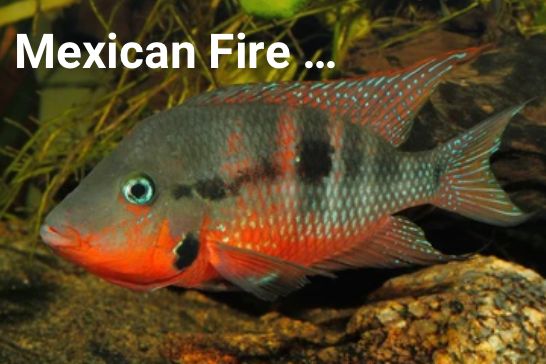
Appearance
They are called firemouth cichlids because of their bright orange-reddish colour that male species get during the season of spawning. One of the very obvious marks on their body is a black spot which is present on the lower portion of the operculum. Some of them also have lateral dark bars along the sides of their body. Firemouth cichlids grow really fast so if you want them to reach their maximum size then make sure you provide them with a healthy balanced diet.
Do firemouths have teeth?
Yes, they have quite sharp teeth in their upper and lower jaw.
Difference between male and female Firemouth cichlids
They both look completely different. Male Firemouth cichlids are large in size and they have bright colored bodies. On the other hand, female firemouth cichlids look more round in shape because they have round bellies. Male firemouth cichlids are bigger and they reach about 6 inches in size, female firemouth cichlids are smaller and only reach about 4-5 inches.
How long do firemouth cichlids live?
If you take good care of firemouth cichlids then they can have a lifespan of 10 years. So it depends purely on your way of care and what you feed them. Following you can learn about how you can care properly.
Care requirements
It is not very difficult to take care of firemouth cichlids. You only need to follow some requirements, the most important thing is to take care of the water conditions when it comes to firemouth cichlids.
Let’s discuss their care requirements in detail
Tank size and tank requirements
According to my experience, the ideal tank size for firemouth cichlids should be of 30 gallons. Firemouth cichlids are larger fishes so they need plenty of place to swim freely. If you are planning to keep more than one firemouth cichlid then you must add additional 5-10 gallons for every new fish.
Firemouth cichlids are territorial so when it comes to tank setup you must have plenty of hiding spots for them so each firemouth cichlid can have their own separate territory. For this, you can add Plants, rocks, or driftwood. For the substrate of the tank, you should have a soft and sandy substrate for firemouth cichlid.
Firemouth cichlids have a habit of digging in the substrate so it’s important to have soft substrate so they don’t get injured while digging in the substrate.
Do firemouth cichlids dig?
Yes, they have a habit of digging so it’s important to have sandy and soft substrate so they don’t get injured.
Filtration system
The filtration system is also very important in the tank of firemouth cichlids. It is very beneficial for the health of your fish. The filtration system will prevent nitrogen compounds to build in the tank as these compounds are very dangerous for the health of your fish. So it’s important to install a filtration system in the tank of your firemouth cichlids.
Ideal water temperature
It’s very important to have accurate water temperatures for firemouth cichlid. The natural habitat of firemouth cichlid is warm water so you need to imitate that in your aquarium tank.
The water temperature in the tank should be
| Water hardness | 8-15 dGH |
| pH levels | 6.5 – 8.0 |
| Water temperature | 75°F to 86°F |
Points to be noted
- Keep the tank clean
- Make sure to keep an accurate water temperature
- Have plenty of hiding spots in the tank
- Make sure your tank is big enough so the fish can easily swim around
- Don’t overcrowd the tank
- Keep a sandy substrate in the tank of firemouth cichlids.
A balanced diet of firemouth cichlid
Firemouth cichlids are foodies and they love to eat. They will literally eat anything that comes their way so it’s your job to feed them with a healthy and balanced diet.
When firemouth cichlids are in the wild, they eat crustaceans and nibble on plants. But in captivity, you can feed them with flakes or pellet food. You should also give them protein-rich items like brine shrimps, bloodworms, etc
You can also occasionally feed them with vegetables or fruits but make sure to feed them in the right way by boiling, peeling, and chopping the veggies or fruits before serving them to your firemouth cichlids. If you observe any uneaten pieces of fruits or veggies in the tank, then immediately remove those pieces to avoid getting the tank dirty.
Points to be noted
- Make sure to provide them with a healthy balanced diet
- Add some proteins to their diet
- Don’t overfeed them as it can cause digestion and bloating issues
- Take out uneaten food items from the tank
Are firemouth cichlids prone to any disease?
Firemouth cichlids are prone to bacterial, fungal, and parasitic diseases. A very common disease that can occur is ich. The symptoms of ich are white spots on the body of fish, especially on fins and gills.
For curing this disease you need to slowly raise the temperature of your tank to 86°F. If you still don’t see any improvements then you need to consult a veterinarian.
How to prevent firemouth cichlid from getting sick
The ideal situation is to follow the care requirements of firemouth cichlid carefully to prevent them from getting sick. You must take care of their diet. Feed them with a healthy balanced diet. Don’t overfeed them as overfeeding can cause bloating and digestion problems. Make sure the temperature of the tank is accurate. Cleanliness is also very important so make sure to keep the tank clean.
If you take care of these factors you can prevent your firemouth cichlid from getting sick.

Are firemouth cichlids aggressive?
Firemouth cichlids are mostly peaceful if they are in a good environment with plenty of place to swim. They do become aggressive and territorial during the spawning season.
Male firemouth cichlids will become super aggressive during spawning.
Are female firemouth cichlids aggressive?
Not much!! They can get aggressive only sometimes if their requirements are not met but they are still less aggressive than male firemouth cichlids.
Reasons firemouth cichlids can get aggressive
- They don’t have enough space in the tank for swimming
- They can get aggressive if you don’t fulfil their nutritional requirements or if their diet is not healthy.
- They become aggressive during spawning.
- Overcrowded tank can make them aggressive
- If they don’t have their own territory spot in the tank they can become aggressive
Breeding of firemouth cichlids
It’s quite easy to breed firemouth cichlids.
Follow these steps for the breeding of firemouth cichlids
- Choose the parent pair. You can buy a pair or you can just get a group of firemouth cichlids and let them choose their partner.
- Slightly increase the water parameters to encourage breeding
- pH level should be 7 to 7.2 for breeding
- The temperature of the water should be 75°F to 80°F
- The surface of the tank should be flat so they can easily lay eggs
- After the mating process, female firemouth cichlid will lay 100 eggs
- The male firemouth cichlid will then protect the eggs
- You must feed good quality food to the baby fry to keep them healthy. You can feed them micro worms or brine shrimps as they are rich in proteins
This is the complete process of breeding which is quite simple even for beginners.
Ideal tankmates for firemouth cichlids
Make sure you have a large tank so every fish in the tank can easily swim around. Firemouth cichlid won’t start a fight until and unless they don’t find enough place to swim or they can’t have their own territory. You can keep with them same size fishes which are not aggressive.
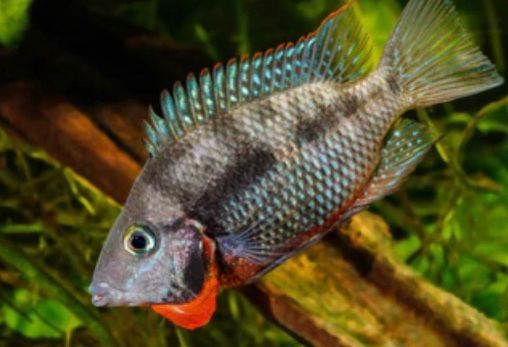
Don’t keep tiny fishes with them as firemouth can bully tiny fishes and also don’t keep larger fishes than firemouth cichlid as they can get stressed out.
Some of the best tank mates for firemouth cichlids are
- Kuhli loach
- Rainbow fish
- Rummy nose tetra
- Bristlenose pleco
- Clown pleco
- Swordtails
- Platies
- Pictus catfish
- Cory catfish
These tankmates get along really well with firemouth cichlids
What cichlids can go with firemouth?
Cichlids that get along well with firemouth cichlids are
- Electric blue acara cichlid
- Severum Cichlid
- Nicaraguan cichlid
- Rainbow cichlid
- Convict cichlid
- Jack Dempsey cichlid
- Salvini cichlid
Points to be noted
- Don’t keep highly aggressive fishes with firemouth cichlid
- Don’t keep tiny fishes with firemouth cichlids
- Make sure you don’t overcrowd the tank with too many fishes as firemouth cichlids need their own space and territory
Conclusion
Firemouth cichlids are fascinating fish. Their beautiful look and color make them very unique and appealing. Their orangish body brings brightness and colors to the tank so it is definitely a popular pet fish.
Also, it’s a popular cichlid and many fish keepers who like to keep cichlids choose firemouth cichlids as their pets. It is very easy to take care of them and they don’t give much tough time to their owner. They are hardy species which is also a plus point for you. I definitely recommend fish keepers keep firemouth cichlids as their pets because they are peaceful, beautiful, and active at the same time.

